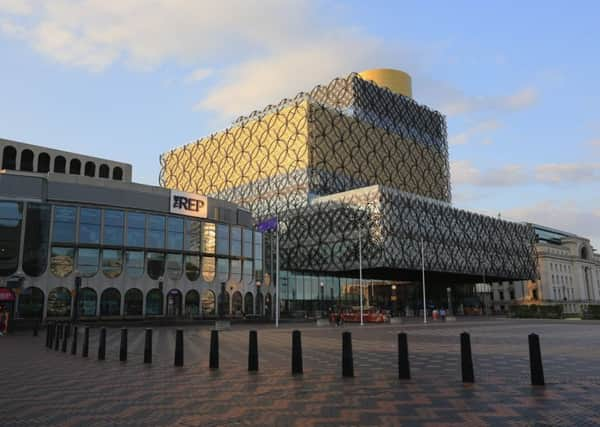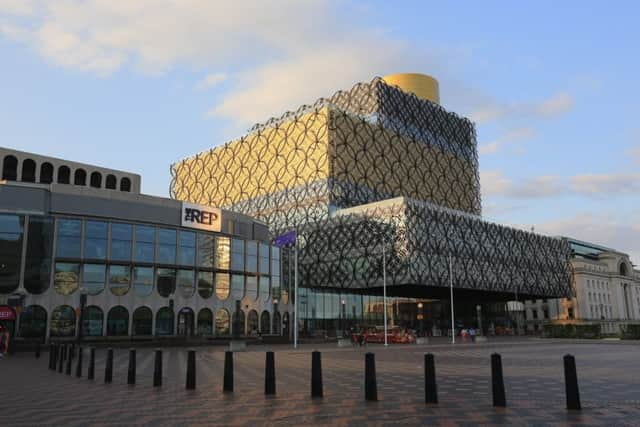Why Birmingham may be a role model for Scottish cities '“ Chris McCall


Their faces said it all. It was a look of slight surprise crossed with mild concern. I had told them I was moving to Birmingham. Whether it was friends, family or colleagues, they struggled to see the appeal of life in the UK’s second largest city.
I would explain I was moving for a three-month work secondment. It was too good an opportunity to turn down. I planned to travel home to Glasgow most weekends. Exploring a new city would be fun.
Advertisement
Hide AdAdvertisement
Hide Ad“The only thing I know about Birmingham is there are a lot of motorways,” was a typical response. It had that in common with my home town, I thought. Here was another place that had been determined to bulldoze its way to post-war prosperity. Unlike Scotland’s biggest city, Brum held its nerve and built not one but two ring roads – instead of the half-finished mess inflicted on Charing Cross and Tradeston.


But what did I really know about this sprawling metropolis? That the car was king, of course. Millions of them were built there and thousands of properties had been cleared to make way for the roads its new car-owning society demanded. Birmingham was the UK’s Motown – but with a much heavier musical legacy; Black Sabbath never wrote cutesy soul songs.
“Birmingham’s name is known everywhere,” the broadcaster Jonathan Meades observed two decades ago. “But its people aren’t, and nor is their city; which is in the middle of England and is Middle England. It’s hyperbolically typical of England, yet at the same time it’s hermetic – it’s an ignored voice in the heart of the country.”
It’s fair to say that downtown Brum is still largely dominated by its roads. Yet it’s gradually moving away from the cult of the automobile towards a more sustainable future which could offer examples for Scotland’s major cities.
When I stepped off the train at New Street in September, I was determined I would understand Birmingham by the time I left. I might not grow to love it, I thought, but I would at the very least appreciate what it had to offer.
Stations can tell us a lot about a place, and the story of New Street tells us more than most. It was once a grand Victorian affair with an Italianate style hotel and a spectacular platform canopy designed by Edward Alfred Cowper. It was a terminus that reflected the commercial might of the Midlands.
That fine station roof was one of many Brum landmarks to be damaged beyond repair by the Luftwaffe, while the hotel fell victim to British Rail’s west coast mainline modernisation programme of the early 1960s – the same damned project that blighted London’s Euston station.
The new New Street was generally despised from the off. Instead of providing a beacon of the future, it condemned passengers to a hideous concrete bunker. A costly refurbishment programme began in 2010. While the platforms remain subterranean – meaning diesel fumes still linger – the upstairs is now a bold and bright concourse.
Advertisement
Hide AdAdvertisement
Hide AdThere’s plenty of space for strangers to find their bearings. “If you think it’s bad now, you should have seen it before,” Brummies say, with characteristic self-deprecation. “Brum will be great when it’s finally finished,” is another line you hear regularly. This is a city with a long record of tearing itself down and trying something different.
The New Street rebuild is just one of several ambitious local projects. The redeveloped Bullring shopping centre boasts a Selfridges, the high-end department store long coveted by Glasgow. The city’s modern tram network is currently being extended with little of the fuss seen in Edinburgh.
Here I was, privileged to be witnessing the rebirth of one of the UK’s major cities in real time. Unlike in Dundee, which has chosen to take the Bilbao route of hanging its international appeal on an eye-catching museum, Birmingham has opted to get the basics right. If you can offer numerous decent shops and a gleaming station, visitors will soon follow.
For a city with a long association with the car, it’s investing substantial amounts in public transport. Its suburban rail network has been continuously growing for years. Then there’s the small matter of HS2, the eye-wateringly expensive infrastructure project – or colossal folly, depending on your viewpoint – which will link Birmingham with London via a new high-speed rail line.
In comparison, it strikes me that Scotland’s two biggest cities seem incapable of sorting out public transport in their own backyards. Edinburgh’s buses are the best outside of London but the capital seems uninterested in reopening its extensive network of suburban railways to passengers. The less said about the tram system, the better.
Glasgow, meanwhile, boasts dozens of stations yet is stuck with a bus network that’s grimly tolerated at best. Its own plans for a tram system bit the dust 25 years ago and have never seriously been reconsidered.
Brummies would be the first to tell you their city isn’t perfect. Among other things, it lacks any instantly recognisble landmarks to entice visitors. The council hopes its flash public library, opened in 2013, is becoming one. The 10-storey building positively screams modern civic ambition.
I looked beyond these modern developments whenever I felt the dull ache of home sickness. I was fortunate to stay a short distance from the Birmingham and Worcester canal, one of two major waterways built in the Georgian era.
If you enjoy a stroll along a quiet towpath, Birmingham is your place. It’s one of the few parts of the city you’re guaranteed not see any cars.
